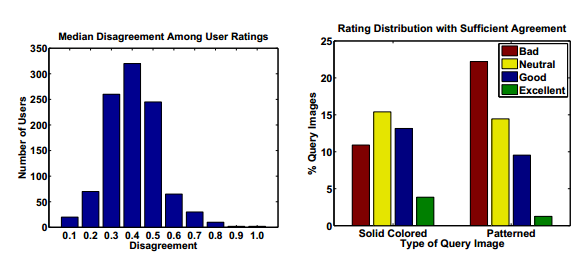How eBay’s Research Laboratories Are Tackling the Tricky Task of Fashion Recommendations
Can a computer algorithm reliably identify clothing combinations that will make you look good? Scientists at eBay’s research labs are trying to find out.
If you’ve ever puzzled over what to wear in the morning, you might also have wondered whether you could leave the choice to an algorithm that could recommend a decent combination of clothes.
The short answer is no. Various groups have studied the problem of automated fashion advice without anybody really nailing it.
Today, it is the turn of Anurag Bhardwaj and pals from eBay Research Labs in San Jose. These guys have developed two different fashion recommendation systems and then crowdsourced opinions about whether the recommendations they provide are any good.
This story is only available to subscribers.
Don’t settle for half the story.
Get paywall-free access to technology news for the here and now.
Subscribe now
Already a subscriber?
Sign in
The results provide some interesting insight into the way humans evaluate clothing but also suggest that automated fashion recommendations still have some way to go.
These guys begin by creating two different fashion recommendation algorithms, which they train on a data set consisting of more than 13,000 photographs of fashion models taken from the Web. In each photograph, the model is wearing a top and bottom combination allowing the algorithms to look for correlations between the different top and skirt combinations.
The first algorithm, which Bhardwaj and pals call the deterministic fashion recommender, evaluates the colors in the top and compares them to the colors in the skirts. It then gives each combination a rating that can be compared to other top-bottom combinations. (Exactly how this rating is calculated, they don’t say.)
So when this algorithm is queried by showing it a particular top, for example, it searches its database looking for a bottom that when combined, produces a high rating.
The second algorithm uses the predefined rule that patterned clothing coordinates well with clothing that has a solid color. “In other words, having busy patterns in both top and bottom clothing is less popular,” say Bhardwaj and co.
So this algorithm ensures that when it is presented with a patterned top, for example, all of its recommendations will be for a skirt with a solid color.
But are these recommendations are any good? To find out, Bhardwaj and pals asked 150 people on Amazon’s Mechanical Turk service to rate the recommendations on a scale of bad, neutral, good, or excellent.
They generated the recommendations by presenting each algorithm with an image chosen at random from a database of 1,000 pictures of skirts. The algorithm then had to choose a top taken from a separate database of images of tops.
The results show certain patterns of preference among the users. For example, people prefer a solid-colored skirt with a patterned top combination.
More interestingly, users also preferred simple patterns, such as polka dots, solids, stripes or plaid, rather than complex patterns such as animal, floral, geometric, or paisley patterns. And when providing a rating, users perform the task more quickly when presented with simple patterns than with complex patterns.
Bhardwaj and co say this makes sense since neuroscientists have long known that the complexity of an image determines the time it takes to visually process it.
Just how useful this will be in developing fashion recommendation algorithms in future isn’t clear. One potential problem is that Bhardwaj and co provide no information about the users they employed on Amazon’s Mechanical Turk. They say nothing about the distribution of men and women, about the age groups involved, their ethnicities, and so on. All these factors could have a significant effect on fashion choices.
What’s more, it’s conceivable that people who choose to work as Turks are a self-selecting group with very specific characteristics when it comes to fashion. But from this paper, it’s impossible to tell.
The stakes are potentially significant. One advantage of recommendation algorithms is that they can significantly increase sales if they work well. That’s something that Amazon, Netflix, Apple, and the like have all discovered to their advantage. The possibility that a fashion recommendation algorithm could help “upsell” customers will provide plenty of motivation for more research in this area.
For the moment, though, one thing is clear. The construction of fashion recommendation systems is a tricky task and one that is likely to remain beyond state-of-the-art for some time to come.
Ref: http://arxiv.org/abs/1405.4013 : Enhancing Visual Fashion Recommendations with Users in the Loop
